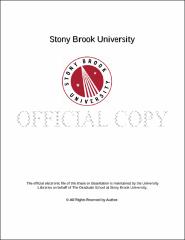| dc.identifier.uri | http://hdl.handle.net/11401/77167 | |
| dc.description.sponsorship | This work is sponsored by the Stony Brook University Graduate School in compliance with the requirements for completion of degree. | en_US |
| dc.format | Monograph | |
| dc.format.medium | Electronic Resource | en_US |
| dc.language.iso | en_US | |
| dc.publisher | The Graduate School, Stony Brook University: Stony Brook, NY. | |
| dc.type | Dissertation | |
| dcterms.abstract | The sperm acrosome reaction (AR), an essential step in mammalian fertilization, is mediated by a highly species-specific interaction of sperm surface molecules with glycan moieties on the egg. Many previous studies indicate that a subset of terminal carbohydrate residues on the mouse egg zona pellucida (ZP) trigger the AR by cross-linking or aggregating receptors on the sperm membrane. However, the exact role of those carbohydrates in AR has not been identified and the mechanism underlying the induction of the AR still needs further investigation. To study this process, a series of synthetic glycopolymers were synthesized. The glycopolymer is composed of a multivalent scaffold (norbornene), a functional ligand (previously identified ZP terminal carbohydrates), and a linker connecting the ligand and the scaffold. The polymers were tested for their ability to initiate AR and through which signaling pathways AR induction occurred. Our data demonstrate that mannose, fucose, and β -N-acetylglucosamine 10-mers and 100-mers initiate AR in a dose-dependent manner, and the 100 mers are more potent on a per monomer basis than the 10-mers. Although nearly equipotent in inducing the AR at the optimal concentrations, the 100-mers bind to different receptors on the sperm and their AR activation kinetics are not identical. Similar to mouse ZP3, all 100-mer-activated AR are sensitive to guanine binding regulatory proteins (G-proteins), protein tyrosine kinase, protein kinase A, protein kinase C and calcium related antagonists. Thus, the chemotypes of synthetic glycopolymers mimic the physiologic AR-activation agents and provide evidence that occupation of one of at least three different receptor binding sites is sufficient to initiate the AR. | |
| dcterms.available | 2017-09-20T16:52:08Z | |
| dcterms.contributor | Sampson, Nicole S | en_US |
| dcterms.contributor | Carrico, Isaac | en_US |
| dcterms.contributor | London, Erwin | en_US |
| dcterms.contributor | Miller, W.. | en_US |
| dcterms.creator | Wu, Linghui | |
| dcterms.dateAccepted | 2017-09-20T16:52:08Z | |
| dcterms.dateSubmitted | 2017-09-20T16:52:08Z | |
| dcterms.description | Department of Chemistry. | en_US |
| dcterms.extent | 208 pg. | en_US |
| dcterms.format | Monograph | |
| dcterms.format | Application/PDF | en_US |
| dcterms.identifier | http://hdl.handle.net/11401/77167 | |
| dcterms.issued | 2013-12-01 | |
| dcterms.language | en_US | |
| dcterms.provenance | Made available in DSpace on 2017-09-20T16:52:08Z (GMT). No. of bitstreams: 1
Wu_grad.sunysb_0771E_11558.pdf: 7130447 bytes, checksum: 168c5f6de0e639d49a44dbd6494dead7 (MD5)
Previous issue date: 1 | en |
| dcterms.publisher | The Graduate School, Stony Brook University: Stony Brook, NY. | |
| dcterms.subject | Chemistry | |
| dcterms.subject | acrosome reaction, glycopolymer, multivalent, ROMP, sperm | |
| dcterms.title | Investigation of the mouse sperm acrosome reaction with synthetic glycopolymers | |
| dcterms.type | Dissertation | |

